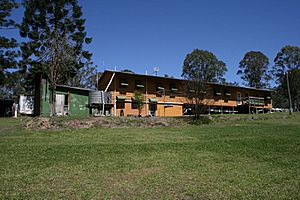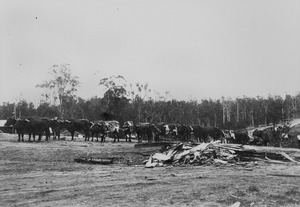Jimna Single Men's Barracks facts for kids
Quick facts for kids Jimna Single Men's Barracks |
|
|---|---|

Former Jimna Single Men's Barracks, 2007
|
|
| Location | J4 Tip Road, Jimna, Somerset Region, Queensland, Australia |
| Design period | 1919 - 1930s (interwar period) |
| Built | 1930s |
| Official name: Jimna Single Men's Barracks (former) | |
| Type | state heritage (built) |
| Designated | 27 November 2008 |
| Reference no. | 602685 |
| Significant period | 1930s |
| Significant components | barracks - workers, kitchen/kitchen house, room/unit/suite |
| Lua error in Module:Location_map at line 420: attempt to index field 'wikibase' (a nil value). | |
The Jimna Single Men's Barracks is a special old building in Jimna, Australia. It was built in the 1930s. This building was once home to many single men who worked in the local timber industry. It is now listed on the Queensland Heritage Register, meaning it's an important part of Queensland's history.
Contents
A Look Back: Jimna's Timber Story
The Jimna Single Men's Barracks shows us how the timber industry grew in southern Queensland. Jimna was a private town built just for timber workers. The barracks gave these workers a place to live in a faraway area. It was a key part of the Hancock and Gore Ltd company's operations. This company ran the timber town of Jimna for about 50 years, starting in 1922. They cut down trees from both natural forests and tree farms.
Why Jimna Was Important for Timber
By the early 1900s, many easy-to-reach trees near the coast were gone. Timber companies had to move inland. The Kilcoy railway line, which reached Kilcoy in 1913, made it easier to get timber from places like Jimna.
Jimna was a good spot for a sawmill town. It was high up on the Jimna Range, about 40 km from Kilcoy. Being close to the railway line made it possible to transport timber. Sawmills were often built in the countryside to save money on shipping. It was cheaper to send cut timber than whole logs. Sawmill towns also needed good water supplies and lots of trees nearby.
Hancock and Gore: A Big Timber Company
Hancock and Gore Ltd was a very large timber company in Queensland. It started in 1872 as Hancock Brothers Ltd. The company grew a lot under Josias Henry Hancock, the founder's grandson. They built mills in many rural areas and in Brisbane.
By 1945, Hancock and Gore became Australia's biggest maker of plywood. They kept growing and became the largest timber company in Queensland around 1955.
How Jimna Town Began
The town of Jimna started in 1922. The sawmill and many buildings, like houses, a shop, and a school, were moved from a place called Monsildale. People started living in the houses in August 1922. By November, the mill was working. It cut timber to build new houses and fix old ones. The shop and butcher's also moved and opened right away.
Jimna grew over the next few decades. In 1924, about 150 people lived there, including 65 children. A new state school was built in 1934. The town's population grew to over 300 after tree planting started in the 1930s. Jimna was busiest when both pine and hardwood mills were running after 1943. The town had its own sports clubs and a hall for dances and church services. Hancock and Gore even supplied meat from their own farms.
Hancock and Gore Ltd controlled everything in Jimna, including the timber cutters. The mill at Jimna was made bigger in 1922. By 1924, it could cut 80,000 super feet of pine every week. At first, it only cut hoop pine using steam-powered saws. In 1933, the mill cut about 23,000 feet of logs daily. These logs were turned into wide boards and building timbers. Some logs were sent to Brisbane to make plywood. Bullock teams and lorries brought timber to the mill. Other lorries took the cut timber to the Kilcoy railway station for shipping.
Protecting Queensland's Forests
The area around Jimna was once full of rainforest and hoop pine. This valuable timber was eventually all cut down. Around 1935, Jimna became a place for new tree-planting experiments. A Forest Ranger started a tree nursery there. Hoop pine tree farms began in the region in 1938.
People worried about losing native timbers in the 1930s. This led to the creation of tree farms in south-east Queensland. By the late 1800s, it was clear that cutting down trees so fast was not sustainable. Groups and sawmill owners asked for better forest management. In 1897, new laws allowed for State Forests to be created. A Forestry Branch was set up in 1900 to protect well-timbered lands.
Important steps were taken by Norman William Jolly, who became Director of Forests in 1910. He saw the need to regrow native forests and plant new trees. His successor, Edward Swain, started the first commercial tree farms in 1920-1921. An independent Forestry Department was created in 1924. They surveyed the remaining forests and realized more State Forests and tree farms were needed.
Changes and Closure of the Mill
The Jimna sawmill continued to improve and grow in the 1930s and 1940s. In 1935, an electric planing machine was installed. A generator powered it, and also supplied electricity to homes and streetlights. In 1943, a hardwood mill started. When the pine mill burned down in 1947, it was rebuilt quickly with modern machines. The Forestry Department started milling pine from their tree farms at Jimna around 1947 or 1948. They kept working in the area after that.
The Jimna mill closed in the early 1970s. It became cheaper to send logs to mills closer to the coast. The mill was taken apart in the mid-1970s. After that, the shops and post office closed as workers left. Many houses were torn down or burned. By 1984, the Forestry Department offered to sell the properties to residents.
In 2007, some parts of the old timber town were still there. These included the Single Men's Barracks and its cookhouse. Some houses, the old school buildings, and the community hall also remained.
Changes to the Barracks Over Time
The Single Men's Barracks has changed a bit over the years. The front porch (verandah) is now partly closed in with windows. It has also been divided into two sections. Some single rooms inside have been opened up to make larger flats. A small deck was added on the north side. Steel supports were put under the building.
The cookhouse looks mostly the same. The old cooking stove was removed and a new one put in. The garden and fence in front of the barracks have also changed since 1984.
It's hard to know exactly when the barracks was built without old records. But it was likely built between late 1922, when the sawmill started, and the beginning of World War II. This was a time when the mill was growing.
What the Barracks Looks Like
The Jimna Single Men's Barracks and its cookhouse are located in the northern part of the Jimna State Forest. They are about 1.5 km from the main road. The barracks building and cookhouse are on the eastern side of a large piece of land on Tip Road. Other timber buildings are on the western side of the land. You get to the site from the road to the south. The barracks and cookhouse sit on a grassy hillside that slopes down to the north.
The Single Men's Barracks has a gable roof, which means it has two sloping sides that meet at a ridge. It is about 30 meters long and 5 meters wide. The building is raised off the ground on steel poles. At the eastern end, some rooms are built into the slope of the ground with concrete blocks. The cookhouse is about 2 meters away from the barracks. It is at the eastern end, and its floor is about the same level as the rooms underneath the barracks. Nearby are a timber shed, a caravan, and a shelter. Three large bunya and hoop pine trees stand among these buildings. There is a fenced yard with gardens in front of the barracks.
Inside the Barracks
The roof of the barracks is made of corrugated iron. The walls are covered in weatherboards. A semi-enclosed porch (verandah) runs along the entire southern side of the building. The bottom part of the verandah is covered in weatherboards. Above that, it has different types of windows. You can get onto the verandah from a ramp on the west side or from stairs in the middle of the south side.
There are twelve windows on the northern side of the building. Some of these have been changed into a door to a small wooden deck. The older windows are sealed with flyscreens and can be closed with wooden shutters.
Inside the barracks, you can still see where twelve small rooms were. Each room is about 3 meters deep and 2.4 meters wide. The verandah has been divided by a wall. The first room on the west end is used as a laundry. Some rooms have been joined together to make larger living spaces, like a flat for the owner. The walls and ceilings of all twelve rooms are covered in fibrous cement sheeting. The walls between rooms are thin, with exposed timber frames.
The Cookhouse
The cookhouse is a rectangular building. It is about 4.5 meters wide and 6.5 meters long. It is covered entirely in corrugated iron. The iron walls are fitted between large, rough timber posts. A narrow part of the roof sticks up about one meter higher than the rest of the roof. This forms a chimney for the stove inside. A large sliding corrugated iron door covers the entire western side of the cookhouse. There is also a window on the south side and a door on the north side.
Inside, the cookhouse is one big room with unlined walls. Along the eastern wall are two old Crown cast-iron stoves. The one in the middle was used when the timber town was busy. It sits on brick walls. The floor is made of brick. The walls, especially near the stove, are covered in black grease and smoke.
Why the Barracks is a Heritage Site
The Jimna Single Men's Barracks was added to the Queensland Heritage Register in 2008 for several reasons:
- It shows how Queensland's history changed. The barracks shows how the timber industry grew in southern Queensland. It represents the time when timber was cut from inland areas after coastal forests were used up. It also shows how private companies built towns and housing for their workers in remote areas.
- It is a rare example of its kind. The Jimna Single Men's Barracks is one of the few remaining parts of a private timber town. These towns were once common but have mostly disappeared. It's a rare example of housing provided by a private timber company for its workers.
- It shows what this type of place was like. The barracks is a good example of the buildings found in private timber towns. It shows what housing for unmarried timber workers in faraway places looked like. It has a long timber building with single rooms and a long porch. It also has a well-preserved cookhouse made of timber and corrugated iron.
- It has a special link to an important group. The Jimna Single Men's Barracks is strongly connected to Hancock and Gore Limited. This company was one of Queensland's biggest timber firms. They built the town of Jimna in 1922 to cut and mill timber. They also provided homes and services for their workers for about 50 years.


